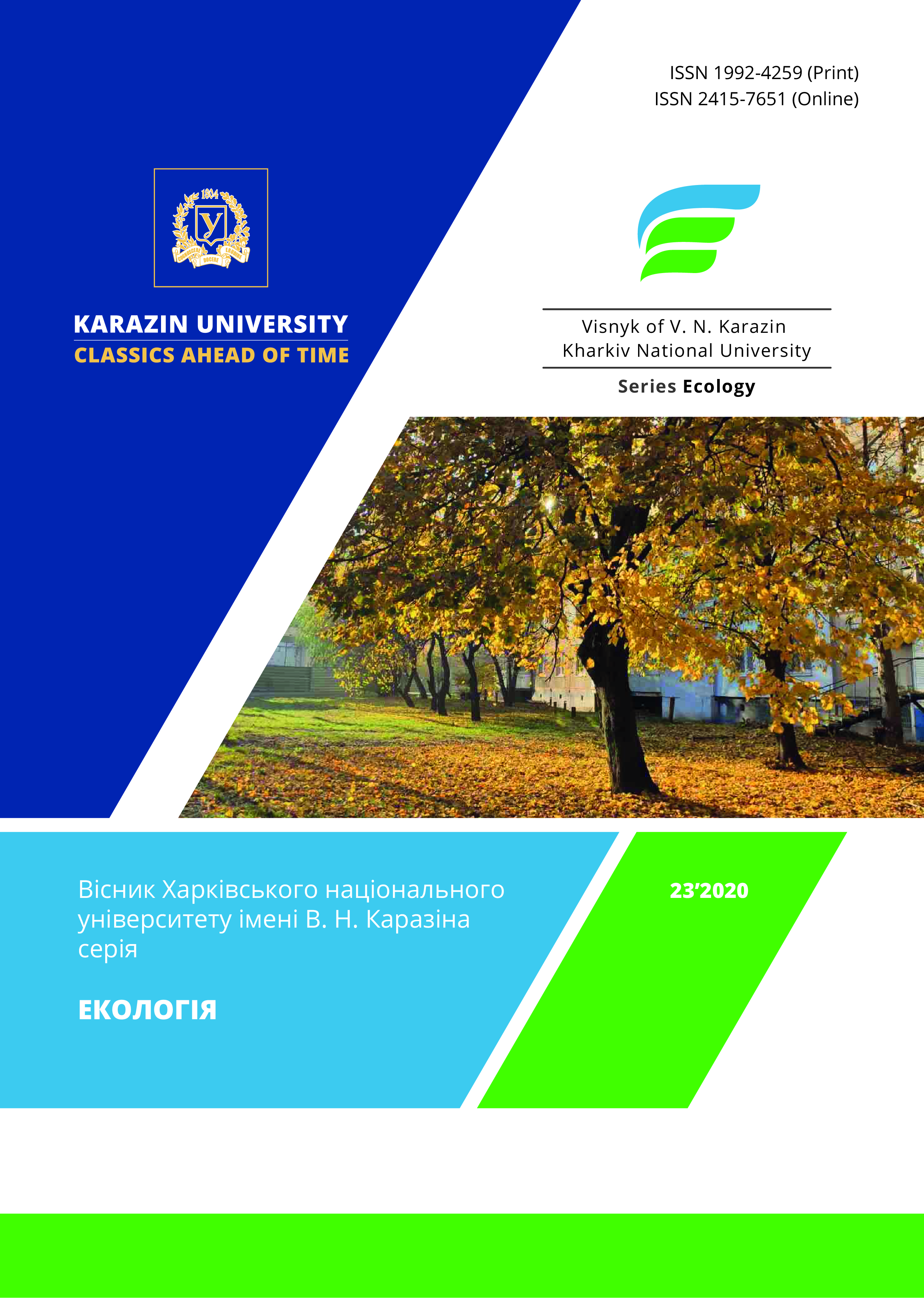Use of Silicon Dioxide Encapsulation Method for Restoration of Oil-Polluted Soils
Abstract
Purpose. Approbation of the method of encapsulation of silicon dioxide to restore the biological value of oil-contaminated soil.
Methods. The encapsulating solution was prepared using sodium silicate (7% w. / vol.) as the main component and a synthetic surfactant (sodium dodecyl sulfate). To restore the contaminated soil, a treatment solution ratio of 1:1, 1:2, 1:3 and 1:4 was used for sodium silicate and sodium dodecyl sulfate, respectively. Phytotoxicity of oil-contaminated soil was determined by biotesting aqueous extracts from the soil.
Results. The most optimized for use from the studied ratios of substances is a solution consisting of 2 parts: sodium silicate and sodium dodecyl sulfate. The lowest phytotoxic effect (17%) was recorded at pH of 5 of the treated soil and the ratio of solution components 1:2 (sodium silicate / sodium dodecyl sulfate). In the experiments, 2 species of monocotyledons (oats, corn) and 2 species of dicotyledonous plants (lettuce, black radish) were used.
Conclusions. The technology of encapsulation of silicon dioxide in the treatment of oil-contaminated soils with a solution of sodium silicate and sodium dodecyl sulfate is quite economically attractive. The material formed as a result of the encapsulation process dries, forming an amorphous silica material, within which, in our opinion, hydrocarbons and heavy metals accumulate, but further research is needed for such a statement.
Downloads
References
Krainyukov, O. (2007). Assessment of the ecological danger of soil pollution by oil products. Protection of the Environment from Anthropogenic Load, (14-16), 210-219. (in Ukrainian)
Edema, N.E. & Asagba, S.O. (2007). Influence of nutrient supplementation on crude oil induced toxicity in Okra (Abelmoschus esculentus). Nigerian Journal of Science and Environment, 6, 58-66.
Akpoveta, V.O., Egharevba, F. & Medjor, W.O. (2011). A pilot study on the biodegradation of hydrocarbon and its kinetics on kerosene simulated soil. Int. J. Environ. Sci., 2 (1), 54-67. Retrieved from http://www.indianjournals.com/ijor.aspx?target=ijor:ijes&volume=2&issue=1&article=005
Akpoveta, V.O., Egharevba, F. & Medjor, O.W., (2011). Ize-Iyamu Microbial degradation and its kinetics on crude oil polluted soil. Res. J. Chem. Sci., 1 (6), 2231-2606. Retrieved from https://www.researchgate.net/profile/Akpoveta_Vincent/publication/288255562_Surfactant_enhanced_soil_washing_technique_and_its_kinetics_on_the_remediation_of_crude_oil_contaminated_soil/links/573592d308ae9ace840aaa70/Surfactant-enhanced-soil-washing-technique-and-its-kinetics-on-the-remediation-of-crude-oil-contaminated-soil.pdf
Akpoveta, V.O. (2016). Fenton oxidative mechanism and its kinetics on the remediation of soil contaminated with unrefined petroleum oil J. Chem. Soc. Niger., 41 (2), 54-61. Retrieved from http://journals.chemsociety.org.ng/index.php/jcsn/article/view/71
Koolivand, A., Rajaei, M.S., Ghanadzadeh, M.J. & Saeedi, R. (2017). Bioremediation of storage tank bottom sludge by using a two-stage composting system: effect of mixing ratio and nutrients addition Biores. Tech-nol., 235, 240-249. Retrieved from https://www.sciencedirect.com/science/article/abs/pii/S0960852417303814
Koolivand, A., Godini, K., Saeedi, R., Abtahi, H. & Ghamari, F. (2018). Oily sludge biodegradation using a new two-phase composting method: kinetics studies and effect of aeration rate and mode. Process Biochem., 79, 127-134. Retrieved from https://www.sciencedirect.com/science/article/abs/pii/S1359511318314144
Koolivand, A., Naddafi, K., Nabizadeh, R., Saeedi, R. (2018). Optimization of combined in-vessel composting process and chemical oxidation for remediation of bottom sludge of crude oil storage tanks Environ. Tech-nol., 39 (20), 1-18. Retrieved from https://www.tandfonline.com/doi/abs/10.1080/09593330.2017.1362037
Medjor, O.W., Akpoveta, O.V., Egharevba, F. (2018). Kinetics and physicochemical studies of surfactant enhanced remediation of hydrocarbons contaminated groundwater Egypt. J. Petrol., 27, 169-176.
http://dx.doi.org/10.1016./j.ejpe.2017.02.005
Akpoveta, O.V. (2016). Kinetics of the treatment of heavy metals contaminated soils using locally sourced ash as a remediation technique. Chemtec journal, 11, 188-204. Retrieved from https://www.sciencedirect.com/science/article/pii/S1110062116302604
Naghipour, D., Jaafari, J., Ashrafi, S.D., Mahvi, A.H. (2017). Remediation of heavy metals contaminated silty clay loam soil by column extraction with ethylenediaminetetraacetic acid and nitrilo triacetic acid J. En-viron. Eng., 143 (8), 1-8. Retrieved from https://www.sciencedirect.com/science/article/abs/pii/S2213343716302846
Medjor, W.O., Namessan, O.N., Medjor, E.A. (2018). Optimization, kinetics, physicochemical and ecotoxicity studies of Fenton oxidative remediation of hydrocarbons contaminated groundwater Egypt. J. Petrol., 27, 227-233. Retrieved from https://www.sciencedirect.com/science/article/pii/S1110062117300387
SO 11269-1:2012 Soil quality – Determination of the effects of pollutants on soil flora – Part 1. Method for the measurement of inhibition of root growth. (2012). Retrieved from https://www.iso.org/standard/51388.html
ISO 11269-2:2005 Soil quality – Determination of the effects of pollutants on soil flora. Part 2. Effects of chemicals on the emergence and growth of higher plants. (2005). Retrieved from https://www.iso.org/standard/36425.html
Krainyukov, O., Kryvytska, I. (2017). Method of determining the degree of soil contamination. Patent of Ukraine for useful model. G01N 33/24 (2006.01). № 113560; declared 16.05.2016; published 10.02.2017, Bulletin, (3). Retrieved from https://base.uipv.org/searchINV/search.php?action=viewdetails&IdClaim=232025 (In Ukrainian).
Mbhele, P.P. (2007). Remediation of Soil and Water Contaminated by Heavy Metals and Hydrocarbons using Silica Encapsulation. (Masters thesis). Department of Chemistry, University of the Witwatersrand, Jo-hannesburg, South Africa. Retrieved from https://www.semanticscholar.org/paper/Remediation-of-soil-and-water-contaminated-by-heavy-Mbhele/fabbc50b78973f77c4bfb5741a57306a551ab0a4?p2df
Authors who publish with this journal agree to the following terms:
- Authors retain copyright and grant the journal right of first publication of this work under the terms of a license Creative Commons Attribution License 4.0 International (CC BY 4.0).
- Authors are able to enter into separate, additional contractual arrangements for the non-exclusive distribution of the journal's published version of the work (e.g., post it to an institutional repository or publish it in a book), with an acknowledgement of its initial publication in this journal.
- Authors are permitted and encouraged to post their work online (e.g., in institutional repositories or on their website) prior to and during the submission process, as it can lead to productive exchanges, as well as earlier and greater citation of published work.





